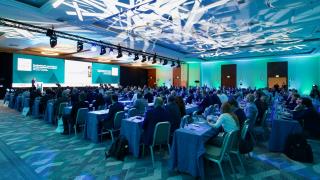Cemtech Asia 2024 saw over 325 cement industry professionals come together at the beautiful Shangri-La Hotel in Jakarta, Indonesia, on 2-5 June 2024. With a 53-stand exhibition and talks from industry-leading experts, the event was a great opportunity for insightful presentations, networking and exploration of decarbonisation technologies.
On 2 June, the Cemtech Asia 2024 conference and exhibition got underway, with delegates from 29 different countries arriving at the Shangri-La Hotel.
Thomas Armstrong, International Cement Review’s managing editor, gave a welcome address to set the scene for the next two days of in-depth learning and networking. He provided an overview of the different technology roadmaps for decarbonising the global cement industry, and highlighted the IEA claim that the cement sector needs to achieve annual CO2 intensity declines of four per cent through to 2030, to get back on tract with the Net Zero Emissions by 2050 Scenario. Additionally, he offered a detailed snapshot of the Indonesian cement industry, which represents more than 120Mta of cement capacity, against a demand of just 65.5Mt in 2023.
The Chairman of the Indonesia Cement Association (ASI), Lilik Unggul Raharjo, unveiled Indonesia’s first low-carbon technology roadmap, which will see the industry reduce its carbon emissions in line with the country’s Nationally Determined Contributions, which seek net zero emissions by “2060 or sooner”. Mr Raharjo outlined the ASI’s plans to commit to these guidelines, by making its decarbonisation roadmap legally ratified by November 2024.
The key carbon reduction strategies will be reducing the clinker to cement ratio to 60 per cent by 2050, increasing alternative fuel substitution and adopting innovative technologies. Mr Raharjo also called upon the government to develop a carbon pricing mechanism to support industrial decarbonisation.
In her keynote speech, Putu Nadi Astuti, Director, Ministry of Industry, Government of Indonesia, laid out the economic, legal and environmental considerations of the national decarbonisation process, as well as Indonesia’s roadmap for reaching Net Zero Emissions (NZE) by 2050. She confirmed that the industry roadmap will be elevated into a Ministerial Regulation, to strengthen its legality.
Following this, Peter Hoddinott (Peter Hoddinott Advisory) addressed one of the biggest challenges to the cement industry today. Namely, decarbonising cement while reducing costs and/or increasing output. Often, cost reduction and decarbonisation seem to be at odds with one another, but Mr Hoddinott highlighted the ways in which both can be achieved concurrently. Additionally, he polled the Cemtech audience on what they felt was the highest priority in terms of their operational improvement plans. The majority (30.7 per cent) of delegates said that reducing the clinker/cement ratio was their chief objective.
Chen Guoqing, from the China Building Materials Federation (CBMF), spoke about how carbon neutrality can be achieved faster through technological innovation and international collaboration. He discussed CBMF’s ‘Six-Zero’ factories plan, which sets forth its aim to operate plants using zero purchased electricity, zero fossil energy, zero primary resources, zero carbon emissions, zero waste emissions and zero staff. This ambitious plan may be some time from being realised, however, CMBF has already taken concrete steps towards the ‘Six-Zero’ transformation. For example, the BBMG Corp Yangquan Jidong demonstration project, which saw the use of fully-automated and electric haulage vehicles in operation at the site’s mine.
The International Finance Corporation (IFC), represented by Antonio Della Pelle, discussed its provision of green loans/bonds, sustainability linked loans/bonds and blue loans. These are vital for the decarbonisation of the cement sector as they allow cement producers to overcome the capex barrier to decarbonisation.
Exploring the local industry dynamics, Holger Mørch, technical director at PT Indocement Tunggal Prakarsa Tbk, presented his company’s recent investments into alternative fuels including the installation of FLSmidth’s hotdiscTM Reactor. The key issue for cement producers in Indonesia is not the quantity of waste – as Greater Jakarta’s population of 30m sends 14,000t waste to landfill every day – but the quality of waste fuel. Hence, the system was chosen for its ability to consume non-shredded RDF and other bulky fuels. Indocement’s AF rate is currently 18.3 per cent, and is targeting 42 per cent by 2030.
Reni Wulandari, director of operations for SIG, Indonesia’s largest cement producer with 56Mta capacity, presented the company’s implementation of industry 4.0, which has enabled breakthrough improvements in environmental compliance, safety, product quality, and process efficiency.
The conference papers continued with reviews of advanced manufacturing technologies , including new vertical roller mill and roller press developments (Gebr Pfeiffer and Köppern), low carbon cements and LC3 production in India (TARA), and full carbon capture systems (Air Liquide and Polysius).
Monticha Khammuang, SCG Group, Thailand, presented the company’s decarbonisation strategy, which will see base level emissions of 23.79Mt CO2e in 2020 fall to 16.85Mt in 2030. Strategies include shifting to composite cements, ramping up alternative fuels (targeting 60 per cent in 2030) and developing low carbon products using precast construction technology and 3D printing.
Additional networking opportunities
Cemtech’s 53-stand exhibition gave delegates a chance to get a close-up look at these incredible technology providers. Cement producers had the opportunity to hear about how these innovations can reduce their costs, increase their output and aid them in the pursuit of their 2050 net zero targets (aligned with industry roadmaps).
On 4 June the Cemtech Asia 2024 conference and exhibition culminated in a cocktail reception, followed by a spectacular Gala Dinner, which rounded off three days of knowledge exchange and collaboration between cement industry professionals.
On the final day of the event, 60 delegates visited Indocement’s 18.7Mta Citeureup plant for a tour of this facility.
Cemtech and International Cement Review would like to extend a huge thank you to all of its exhibitors, speakers, delegates and sponsors for supporting this incredible event.
This article was first published in International Cement Review in July 2024.
